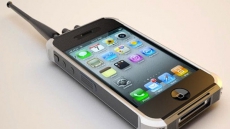LAS VEGAS — Turns out that smart TVs can be, well, pretty dumb.
Even moderately priced sets can now connect to the Internet and run Netflix and other apps — that's the "smart" part. Yet many people are ignoring the built-in features and turning to Apple TV, Roku and other stand-alone streaming devices that often do a better job.
In an August report, the NPD Group estimates that roughly a third of smart TVs in the U.S. weren't actually connected to the Internet. That's down from about half two years earlier, but still not good. Researchers at Parks Associates found that even as more Americans are using smart TV functions, streaming device usage has grown even faster.
"If you're a streaming media box (maker), you've got much more ability to push new features out into the market at an affordable price," says Barbara Kraus, Parks Associates' director of research. "They're very stiff competition for smart TVs."
None of that is slowing down TV manufacturers like Samsung, though, as they continue to tout their newest and smartest models at this week's CES gadget show in Las Vegas.
In a way, putting brains in a device that most people replace only every five to seven years isn't the brightest idea. Chips get faster every year, so by the time you're ready to buy a new set, its brains will be really, really old, at least in technology terms.
The software, though, can present an even bigger problem. Smart TVs are frequently plagued with confusing interfaces, buggy functions and inconsistent updates. They are sometimes mysteriously unable to run new streaming services and may never be updated to add new features to the ones they do run.
Worse, some TV makers focus on bringing new features only to their latest models in an effort to persuade people to buy new sets. Samsung's 2016 models, for instance, implicitly inform anyone who bought last year's sets that they've already been left behind. Those earlier customers won't be able to use their Samsung TVs to set mood lighting or check security cameras in a connected home.
Among the new features in LG's 2016 models: Magic Zoom, which will let viewers zoom in on video while it's playing — using a digital magnifying glass — to make out small text and other details. But LG won't say when, if ever, older TVs will get that.
The divide between smart TVs and streaming devices could become even more pronounced as the devices adopt the types of app stores common on phones and tablets. The new Apple TV offers shopping, travel and food-delivery apps, while Nvidia's Shield Android TV device runs sophisticated games once limited to game consoles and personal computers.

A smart TV is fine if all you're doing is watching video, says Ali Kani, general manager for the Shield business. But he believes "the living room is going to be revolutionized by apps. It's not any more just about Netflix or Hulu."
There's also something to be said about letting TV makers and tech companies focus on what each does best. In other words, when you put your living room in the hands of software created by a hardware company, you may live to regret it.
"There are some TV companies that do a fantastic job of creating beautiful sets with fantastic picture quality," says Lloyd Klarke, Roku's director of product management. "Our focus is on ease of use, experience and content aggregation. It's a different kind of business."
Some TV makers, including Hisense, Sharp and TCL, have turned to Roku's smart TV system for that reason. Because the interface shares technology with Roku's stand-alone streaming devices, app makers can design once for many devices. Plus, Roku smart TVs get software updates about the same time stand-alone devices do.
But Roku isn't bringing streaming video with sharper 4K resolution to those smart TVs until this spring, even though the Roku 4 streaming device had that capability when it came out in October — yet another way buying a smart TV can make you feel like a dunce.
So why do TV makers bother making smart TVs? Call it the business equivalent of FOMO — Fear Of Missing Out.
"What they don't want to be is just a piece of glass," says Jim Denney, TiVo's vice-president of product marketing.
Start with competition. It's very difficult for a manufacturer to make a dumb TV, particularly one larger than about 40 inches, when competitors are all throwing smarts in.
Hardware manufacturers also want to avoid being marginalized the way they were in smartphones. In adopting Google's Android system, companies like Samsung and LG effectively ceded revenue from apps, movies and search ads to Google. On TVs, seen as one of the next frontiers, they want to retain control — and the cash.
To be sure, smart TVs do offer a few economic benefits. If you've got several TVs in your house, it might be cheaper not to buy streaming devices for each set, and instead to rely on built-in features in some rooms.
Some smart TVs also offer seamless switching between regular TV and streaming. Samsung will do this for the first time on 2016 models. A single remote will control both the set and set-top boxes from Dish and Time Warner Cable — and even the Apple TV.
Won-Jin Lee, Samsung's executive vice-president of its visual display business, says consumers get frustrated with too many connected devices plugged into their TVs and a jumble of remote controls. "We wanted this to be a solution that actually fixes the problems that consumers are dealing with," he says.
Meanwhile, with LG's new smart TVs, a touch of a button adds favourite channels from an antenna to the on-screen interface. On Roku's smart TVs, your antenna channels or cable service appears as a tile on the home screen alongside those for Netflix and games.
By contrast, streaming devices typically require viewers to change the input source with the remote, which can lead to confusion and arguments if a family member forgets to change it back.
But there's yet another audience smart TVs continue to alienate: app makers. These software designers have little incentive to write and rewrite their apps for a multitude of incompatible TV systems, such as Samsung's Tizen and LG's webOS, when viewers are voting with their remotes.

The satellite TV company Dish launched an app for LG's smart TVs two years ago, but found "very small usage," and now it is more focused instead on improving its own set-top box, says Vivek Khemka, Dish's senior vice-president for product management. "We have kind of put a pause on these smart TV platforms."





